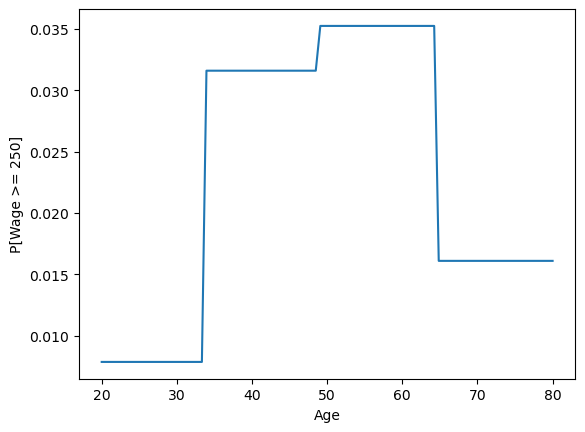Jupyter Notebook#
Lec 22 - Step Functions for Classification#
We’re going to try again with the step functions.
# Everyone's favorite standard imports
import numpy as np
import pandas as pd
import matplotlib.pyplot as plt
%matplotlib inline
import time
# ML imports we've used previously
from sklearn.model_selection import train_test_split
from sklearn.metrics import mean_squared_error
from sklearn.linear_model import LinearRegression
import statsmodels.api as sm
Loading in the data#
We’re going to use the Wage data used in the book, so note that many of your plots can be checked by looking at figures in the book.
df = pd.read_csv('../../DataSets/Wage.csv', index_col =0 )
df.head()
| year | age | sex | maritl | race | education | region | jobclass | health | health_ins | logwage | wage | |
|---|---|---|---|---|---|---|---|---|---|---|---|---|
| 231655 | 2006 | 18 | 1. Male | 1. Never Married | 1. White | 1. < HS Grad | 2. Middle Atlantic | 1. Industrial | 1. <=Good | 2. No | 4.318063 | 75.043154 |
| 86582 | 2004 | 24 | 1. Male | 1. Never Married | 1. White | 4. College Grad | 2. Middle Atlantic | 2. Information | 2. >=Very Good | 2. No | 4.255273 | 70.476020 |
| 161300 | 2003 | 45 | 1. Male | 2. Married | 1. White | 3. Some College | 2. Middle Atlantic | 1. Industrial | 1. <=Good | 1. Yes | 4.875061 | 130.982177 |
| 155159 | 2003 | 43 | 1. Male | 2. Married | 3. Asian | 4. College Grad | 2. Middle Atlantic | 2. Information | 2. >=Very Good | 1. Yes | 5.041393 | 154.685293 |
| 11443 | 2005 | 50 | 1. Male | 4. Divorced | 1. White | 2. HS Grad | 2. Middle Atlantic | 2. Information | 1. <=Good | 1. Yes | 4.318063 | 75.043154 |
df.info()
<class 'pandas.core.frame.DataFrame'>
Index: 3000 entries, 231655 to 453557
Data columns (total 12 columns):
# Column Non-Null Count Dtype
--- ------ -------------- -----
0 year 3000 non-null int64
1 age 3000 non-null int64
2 sex 3000 non-null object
3 maritl 3000 non-null object
4 race 3000 non-null object
5 education 3000 non-null object
6 region 3000 non-null object
7 jobclass 3000 non-null object
8 health 3000 non-null object
9 health_ins 3000 non-null object
10 logwage 3000 non-null float64
11 wage 3000 non-null float64
dtypes: float64(2), int64(2), object(8)
memory usage: 304.7+ KB
df.describe()
| year | age | logwage | wage | |
|---|---|---|---|---|
| count | 3000.000000 | 3000.000000 | 3000.000000 | 3000.000000 |
| mean | 2005.791000 | 42.414667 | 4.653905 | 111.703608 |
| std | 2.026167 | 11.542406 | 0.351753 | 41.728595 |
| min | 2003.000000 | 18.000000 | 3.000000 | 20.085537 |
| 25% | 2004.000000 | 33.750000 | 4.447158 | 85.383940 |
| 50% | 2006.000000 | 42.000000 | 4.653213 | 104.921507 |
| 75% | 2008.000000 | 51.000000 | 4.857332 | 128.680488 |
| max | 2009.000000 | 80.000000 | 5.763128 | 318.342430 |
Here’s the plot we used multiple times in class to look at a single variable: age vs wage
plt.scatter(df.age[df.wage <=250], df.wage[df.wage<=250],marker = '*', label = '< 250')
plt.scatter(df.age[df.wage >250], df.wage[df.wage>250], label = '> 250')
plt.legend()
plt.xlabel('Age')
plt.ylabel('Wage')
plt.show()

Classification version of step functions#
Now we can try out the classification version of the problem. Let’s build the classifier that predicts whether a person of a given age will make more than $250,000. You already made the matrix of step function features, so we just have to hand it to LogisticRegression to do its thing.
# Same matrix of step function features as last time.
df_cut, bins = pd.cut(df.age, 4, retbins = True, right = False)
df_steps_dummies = pd.get_dummies(df_cut) # This gives us entries with true/false
df_steps = df_steps_dummies.apply(lambda x: x * 1) # This converts those to either 0 or 1.
df_steps.head()
| [18.0, 33.5) | [33.5, 49.0) | [49.0, 64.5) | [64.5, 80.062) | |
|---|---|---|---|---|
| 231655 | 1 | 0 | 0 | 0 |
| 86582 | 1 | 0 | 0 | 0 |
| 161300 | 0 | 1 | 0 | 0 |
| 155159 | 0 | 1 | 0 | 0 |
| 11443 | 0 | 0 | 1 | 0 |
from sklearn.linear_model import LogisticRegression
y = np.array(df.wage>250) #<--- this makes sure I
# just have true/false input
# so that we're doing classification
clf = LogisticRegression(random_state=48824)
clf.fit(df_steps_dummies,y)
LogisticRegression(random_state=48824)In a Jupyter environment, please rerun this cell to show the HTML representation or trust the notebook.
On GitHub, the HTML representation is unable to render, please try loading this page with nbviewer.org.
LogisticRegression(random_state=48824)
# Build the same step features for the x-values we want to draw
t_age = pd.Series(np.linspace(20,80,100))
t_df_cut = pd.cut(t_age, bins, right = False) #<-- I'm explicitly passing the same bins learned above so tha the procedure is the same.
t_dummies = pd.get_dummies(t_df_cut)
t_step = t_dummies.apply(lambda x: x * 1)
# Predict on these to get the line we can draw
f = clf.predict_proba(t_step)
below = df.age[df.wage <=250]
above = df.age[df.wage >250]
# Comment this out to see the function better
# plt.scatter(above,np.ones(above.shape[0]),marker = '|', color = 'orange')
# plt.scatter(below,np.zeros(below.shape[0]),marker = '|', color = 'blue')
plt.xlabel('Age')
plt.ylabel('P[Wage >= 250]')
plt.plot(t_age,f[:,1])
plt.show()

Congratulations, we’re done!#
Written by Dr. Liz Munch, Michigan State University

This work is licensed under a Creative Commons Attribution-NonCommercial 4.0 International License.
